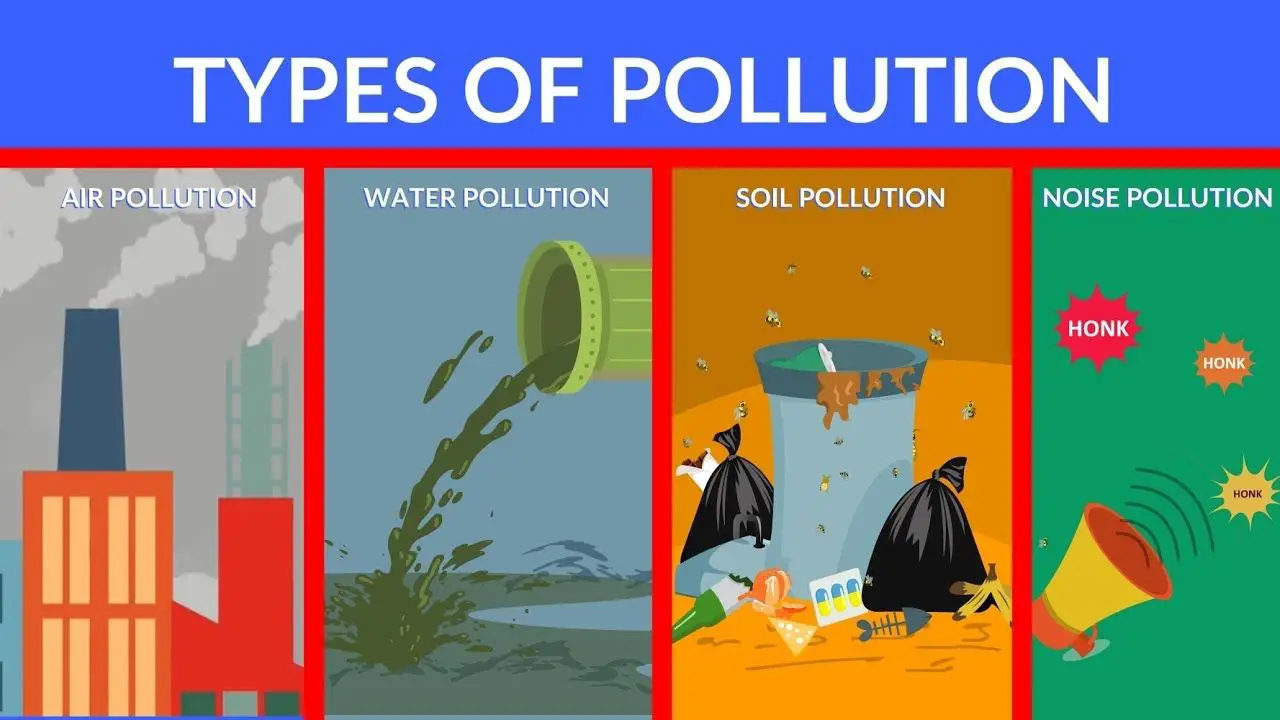1. Air Pollution
Air pollution can be defined as the presence of chemical compounds in atmospheric air that are toxic and are present in concentrations that can be harmful to animals, flora, buildings and humans. Broadly, air pollution suggests the presence of chemical compounds in the air, which are not originally present, but have caused a decrease in air quality. Air pollution also makes adverse changes in the quality of life on Earth through global warming and ozone layer deficiency. Depending on the source, form, and condition, under which pollutants are produced, they have different characteristics, which make their distribution and effects diverse. General gaseous pollutants are sulfur oxide (especially SO2), nitrogen oxide (including NO and NO2), volatile organic compounds (VOCs) and carbon monoxide (co). These gaseous pollutants are classified into primary and secondary pollutants. Primary pollutants (examples are CO, CO2, NO2, and SO2) are pollutants who are directly released into the atmosphere, usually from domestic, industrial or transport sources, while secondary polluting gases and particles are made in the atmosphere, mainly from primary pollutants. For example, the breakdown of ammonium nitrate aerosol, sulfuric acid and hydrocarbons produces atmospheric nitrogen oxide gases, atmospheric sulfur and ozone (O3) respectively.
The extent of damage from air pollutants depends primarily on their chemical composition such as oxidation capacity, solubility, concentrations and sensitivity of the affected person or cheese. For humans, SO2 gases can damage the skin and upper airways because they are soluble in water; Whereas O3 and NO2 can go into the lungs even more depth due to their low solubility. CO is a colorless, odorless, highly soluble and non-glassman-causing gas that has high affinity for hemoglobin than oxygen, thus, it easily enters the bloodstream to form carboxhymoglobin with harmful effects. The PM is usually classified based on its size or aerodynamic diameter: PM10, represents particles with 10 mm diameter; PM2.5 particles consists of 2.5 mm diameter; And PM0.1 particles are of 0.1 mm diameter. Large particles that appear in the form of dust can be carried by air and accumulate in buildings, structures and human eyes. Many health-hiratological pollutants such as polymerromatic hydrocarbons (PAHS) and frequent organic pollutants (POPS).
2. Water Pollution
Water pollution is caused by both man -made and natural sources. Underground water sources can contain naturally found ore that are rich in toxic metals, which cause pollution by dissolving in water bodies. Examples of contamination of arsenic and lead in groundwater sources are associated with such ores. Also, as Evuzi et al. (2020) mentioned, geological structures of different regions contribute extensively to the fundamental structure of water bodies, and thus can cause high concentrations of elements that cause water pollution. Anthropological sources include domestic waste, pesticides and vegetables, food processing waste, pollutants from livestock operations, Voc, heavy metals from electronic waste, chemical waste and medical waste. Air -generated pollutants like PM also bring other organic pollutants to surface water. These pollutants can result in human health problems like stomach pain, vomiting, diarrhea and typhoid. Chemicals such as pesticides, hydrocarbons, POPs or heavy metals can cause harmful health effects such as cancer, hormonal imbalance, reproductive loss and severe liver and kidney damage. Nutrients in the water can cause uterophiation, plant growth and sometimes algae growth, resulting in lack of oxygen, which can increase pollution.
3. Soil pollution
In addition to earthquakes, erosion and other natural disasters that damage the soil, the main sources of soil pollution are industrial and domestic waste. Some soil pollutants include heavy metals, hydrocarbons, inorganic and organic solvent. Garbage, burning garbage and insufficient landfill soil pollution are the main causes. Fossil fuels emanating from petrochemical plants, petroleum refineries and power production plants also promote soil pollution. Divisions through petroleum investigation, refining and road transport often cause soil pollution. Global attention is being paid to land pollution by plastic, one of the reasons for this is the toxic nature of the yozers used in their production and the direct effect of plastic on plants and animals. Plastic waste on the ground is unpleasant to the eyes, can penetrate into the soil and prevent nutrients absorption by plants, and can complicate terrestrial animals. Soil pollution not only causes human health problems, but can also change metabolic processes in plants, resulting in reduced crop yield. Pollutants can also enter the food chain through absorption by plants.
Read Also:
- Environmental Pollution
- Effects Of Pollution On Aquatic Biota
- A Review On The Effects Of Water Pollution On Freshwater Fish Species
- Water Pollution: Causes, Negative Effects And Prevention Methods
- Prevention Of Water Pollution
- Effects And Control Ways of Water Pollution
- Causes Of Water Pollution
- Introduction To Water Pollution
- Introduction To Air Quality And Pollution Control
- Introduction And History Of Anthropogenic Pollution
- Air Pollution And Your Health
- What Is Air Pollution
- Health Effects Of Plastic Pollution
- Air Pollution: Health Effects
- Air Pollution: Health Effects






